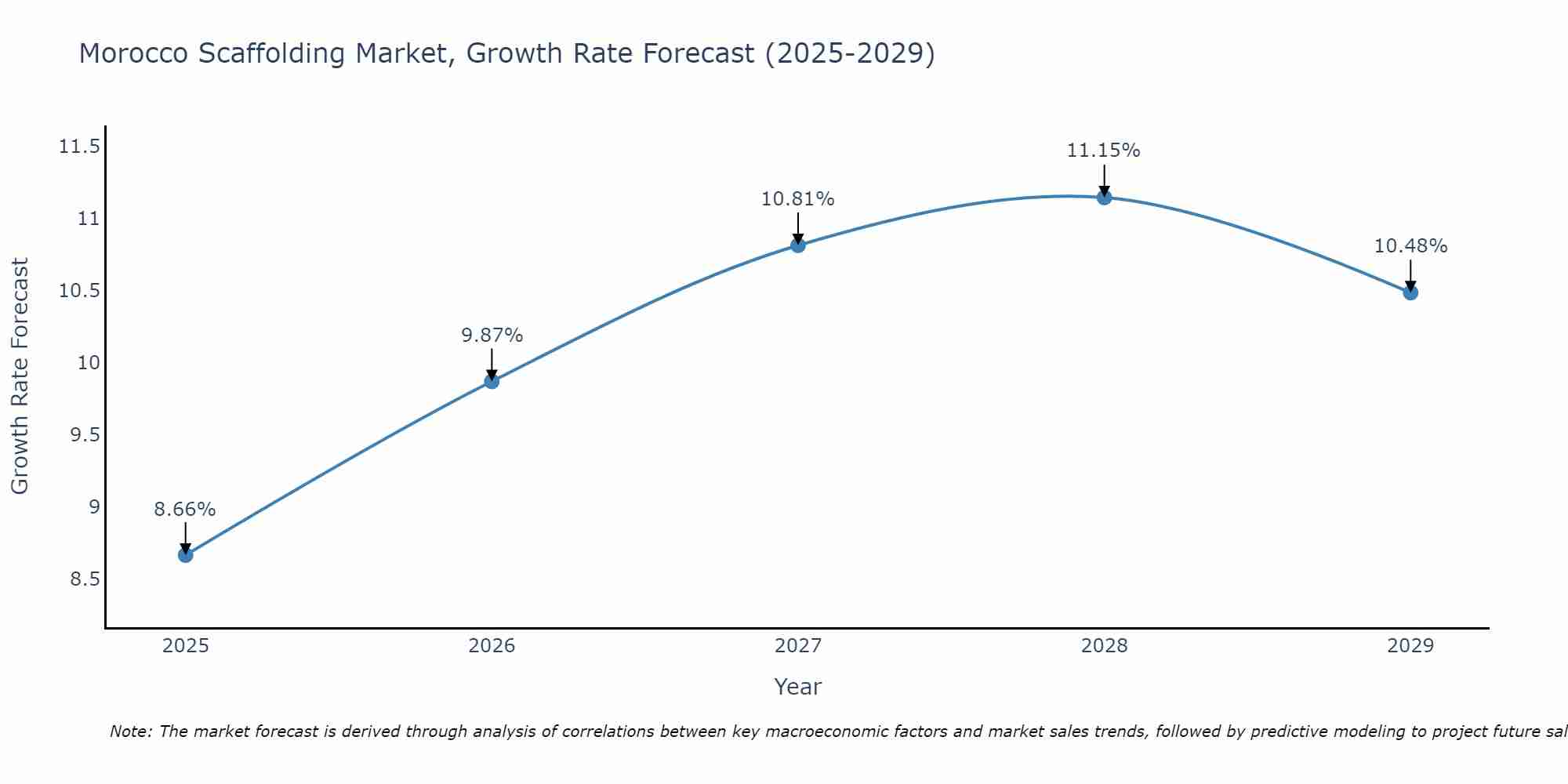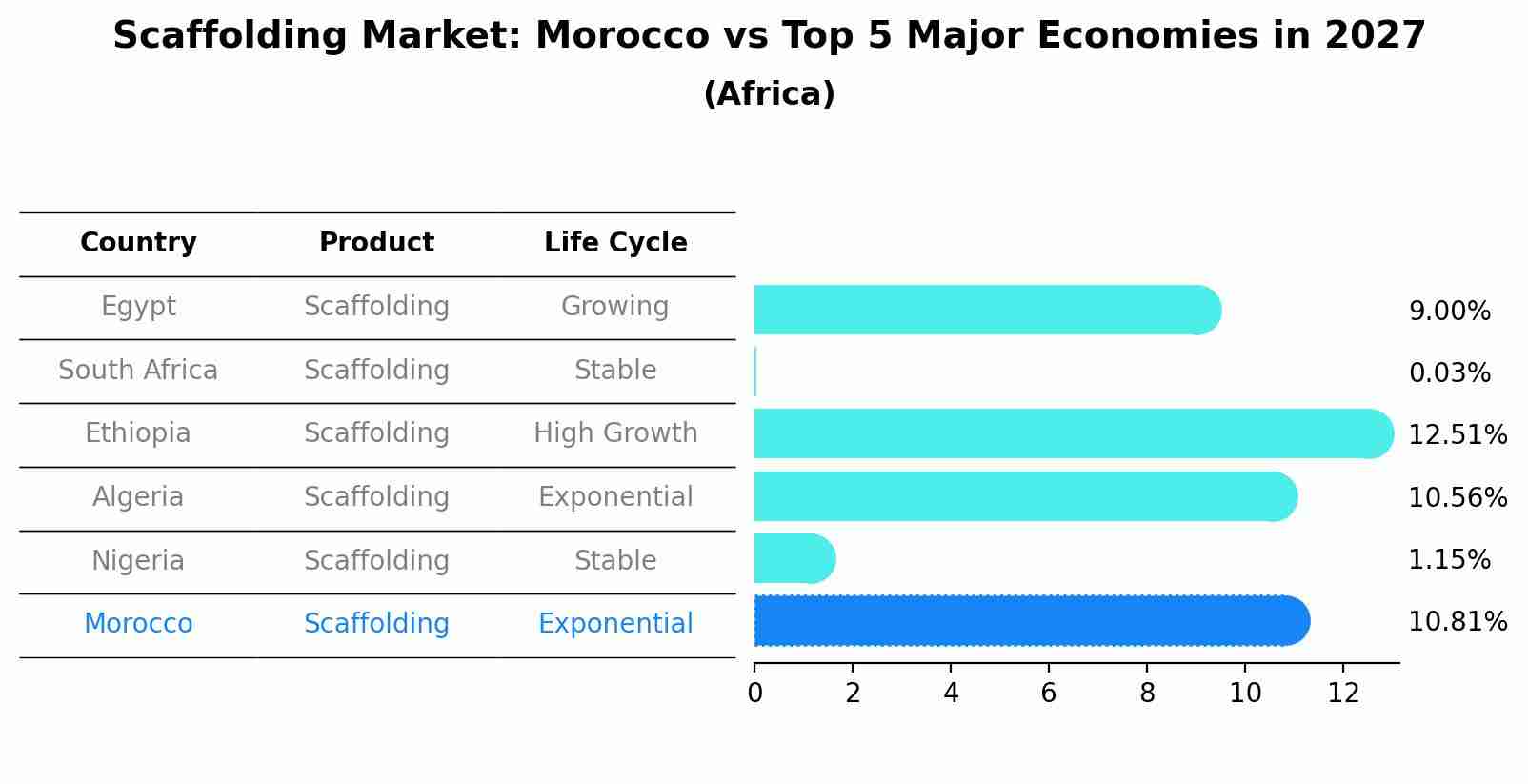Morocco Scaffolding Market Outlook | Industry, Share, Revenue, Companies, Size, Forecast, COVID-19 IMPACT, Trends, Value, Analysis & Growth
| Product Code: ETC377813 | Publication Date: Aug 2022 | Updated Date: Jul 2025 | Product Type: Market Research Report | |
| Publisher: 6Wresearch | Author: Bhawna Singh | No. of Pages: 75 | No. of Figures: 35 | No. of Tables: 20 |
Morocco Scaffolding Market Size Growth Rate
The Morocco Scaffolding Market is projected to witness mixed growth rate patterns during 2025 to 2029. Starting at 8.66% in 2025, the market peaks at 11.15% in 2028, and settles at 10.48% by 2029.

Scaffolding Market: Morocco vs Top 5 Major Economies in 2027 (Africa)
Morocco's Scaffolding market is anticipated to experience a high growth rate of 10.81% by 2027, reflecting trends observed in the largest economy Egypt, followed by South Africa, Ethiopia, Algeria and Nigeria.

Morocco Scaffolding Market Synopsis
The Morocco scaffolding market is experiencing steady growth due to infrastructure development projects in sectors such as construction, oil & gas, and power generation. The increasing urbanization and industrialization in the country are driving the demand for scaffolding solutions to support the construction of high-rise buildings, bridges, and other structures. Key players in the market are focusing on expanding their product offerings to cater to the diverse requirements of customers and comply with stringent safety regulations. Additionally, the adoption of advanced scaffolding technologies like modular and system scaffolding is gaining traction, enhancing efficiency and safety at construction sites. The market is expected to continue its growth trajectory in the coming years, supported by ongoing infrastructure investments and a favorable regulatory environment.
Morocco Scaffolding Market Trends
The Morocco scaffolding market is experiencing steady growth due to increasing construction activities across various sectors such as residential, commercial, and industrial. The demand for scaffolding is driven by infrastructure development projects, urbanization, and renovation activities. Key trends in the market include a shift towards more advanced and durable scaffolding materials to ensure safety and efficiency on construction sites. Additionally, there is a growing emphasis on eco-friendly scaffolding solutions to align with sustainability goals. Companies in the Morocco scaffolding market are focusing on product innovation, customization, and efficient delivery services to meet the diverse needs of construction projects in the country. Overall, the market is expected to continue its upward trajectory as construction activities in Morocco remain robust.
Morocco Scaffolding Market Challenges
In the Morocco Scaffolding Market, some challenges faced include the lack of standardized regulations leading to safety concerns, competition from cheaper alternative construction methods, and limited access to skilled labor for scaffold assembly and dismantling. Additionally, the market may also be affected by economic fluctuations impacting construction activity and investment in infrastructure projects. Companies operating in the Morocco Scaffolding Market need to navigate these challenges by investing in training programs to enhance safety practices, exploring innovative and cost-effective scaffold solutions, and building strategic partnerships to access a skilled workforce. Adapting to regulatory changes, market trends, and economic conditions will be crucial for sustained growth and success in the Morocco Scaffolding Market.
Morocco Scaffolding Market Investment Opportunities
The Morocco scaffolding market presents promising investment opportunities due to the country`s growing construction industry and infrastructure development projects. With increasing urbanization and government initiatives to improve public facilities, there is a rising demand for scaffolding products and services in Morocco. Investors can consider opportunities in supplying high-quality scaffolding materials, rental services for construction projects, and innovative scaffolding solutions tailored to the local market`s needs. Additionally, the focus on sustainable construction practices and safety regulations in Morocco creates a niche for companies offering eco-friendly and safe scaffolding solutions. Collaborating with local construction firms and participating in large-scale projects such as residential complexes, commercial buildings, and industrial facilities can be lucrative strategies for investors looking to enter the Morocco scaffolding market.
Jordan Agar Market Government Policies
The Moroccan government has implemented various policies to regulate the scaffolding market in the country. These policies primarily focus on ensuring the safety and quality standards of scaffolding structures used in construction projects. The government has set guidelines and regulations for the design, installation, and maintenance of scaffolding to prevent accidents and ensure worker safety. Additionally, there are requirements for companies operating in the scaffolding sector to obtain licenses and adhere to specific industry standards. The government also emphasizes the importance of training and certification for workers involved in scaffolding activities to promote professional competence and reduce risks. Overall, these policies aim to enhance the efficiency and reliability of scaffolding services in Morocco while prioritizing the well-being of workers and the public.
Morocco Scaffolding Market Future Outlook
The Morocco scaffolding market is expected to experience steady growth in the coming years, driven by ongoing urbanization and infrastructure development projects in the country. The construction sector in Morocco is witnessing significant investment, particularly in residential, commercial, and industrial projects, which will fuel the demand for scaffolding systems. Additionally, the government`s initiatives to improve the business environment and attract foreign investments are likely to further boost construction activities and drive the scaffolding market. As safety regulations become stricter and the need for efficient construction practices rises, there will be a growing demand for advanced scaffolding solutions in Morocco. Overall, the future outlook for the Morocco scaffolding market appears positive, with opportunities for both domestic and international scaffolding companies to capitalize on the market growth.
Key Highlights of the Report:
- Morocco Scaffolding Market Outlook
- Market Size of Morocco Scaffolding Market, 2021
- Forecast of Morocco Scaffolding Market, 2031
- Historical Data and Forecast of Morocco Scaffolding Revenues & Volume for the Period 2018 - 2031
- Morocco Scaffolding Market Trend Evolution
- Morocco Scaffolding Market Drivers and Challenges
- Morocco Scaffolding Price Trends
- Morocco Scaffolding Porter's Five Forces
- Morocco Scaffolding Industry Life Cycle
- Historical Data and Forecast of Morocco Scaffolding Market Revenues & Volume By Type for the Period 2018 - 2031
- Historical Data and Forecast of Morocco Scaffolding Market Revenues & Volume By Supported Scaffolding for the Period 2018 - 2031
- Historical Data and Forecast of Morocco Scaffolding Market Revenues & Volume By Suspended Scaffolding for the Period 2018 - 2031
- Historical Data and Forecast of Morocco Scaffolding Market Revenues & Volume By Rolling Scaffolding for the Period 2018 - 2031
- Historical Data and Forecast of Morocco Scaffolding Market Revenues & Volume By Material for the Period 2018 - 2031
- Historical Data and Forecast of Morocco Scaffolding Market Revenues & Volume By Aluminum for the Period 2018 - 2031
- Historical Data and Forecast of Morocco Scaffolding Market Revenues & Volume By Wood for the Period 2018 - 2031
- Historical Data and Forecast of Morocco Scaffolding Market Revenues & Volume By Steel for the Period 2018 - 2031
- Historical Data and Forecast of Morocco Scaffolding Market Revenues & Volume By End User for the Period 2018 - 2031
- Historical Data and Forecast of Morocco Scaffolding Market Revenues & Volume By Residential for the Period 2018 - 2031
- Historical Data and Forecast of Morocco Scaffolding Market Revenues & Volume By Commercial for the Period 2018 - 2031
- Historical Data and Forecast of Morocco Scaffolding Market Revenues & Volume By Industrial for the Period 2018 - 2031
- Morocco Scaffolding Import Export Trade Statistics
- Market Opportunity Assessment By Type
- Market Opportunity Assessment By Material
- Market Opportunity Assessment By End User
- Morocco Scaffolding Top Companies Market Share
- Morocco Scaffolding Competitive Benchmarking By Technical and Operational Parameters
- Morocco Scaffolding Company Profiles
- Morocco Scaffolding Key Strategic Recommendations
Frequently Asked Questions About the Market Study (FAQs):
- Single User License$ 1,995
- Department License$ 2,400
- Site License$ 3,120
- Global License$ 3,795
Search
Thought Leadership and Analyst Meet
Our Clients
Related Reports
- Canada Oil and Gas Market (2026-2032) | Share, Segmentation, Value, Industry, Trends, Forecast, Analysis, Size & Revenue, Growth, Competitive Landscape, Outlook, Companies
- Germany Breakfast Food Market (2026-2032) | Industry, Share, Growth, Size, Companies, Value, Analysis, Revenue, Trends, Forecast & Outlook
- Australia Briquette Market (2025-2031) | Growth, Size, Revenue, Forecast, Analysis, Trends, Value, Share, Industry & Companies
- Vietnam System Integrator Market (2025-2031) | Size, Companies, Analysis, Industry, Value, Forecast, Growth, Trends, Revenue & Share
- ASEAN and Thailand Brain Health Supplements Market (2025-2031) | Strategy, Consumer Insights, Analysis, Investment Trends, Opportunities, Growth, Size, Share, Industry, Revenue, Segments, Value, Segmentation, Supply, Forecast, Restraints, Outlook, Competition, Drivers, Trends, Demand, Pricing Analysis, Competitive, Strategic Insights, Companies, Challenges
- ASEAN Bearings Market (2025-2031) | Strategy, Consumer Insights, Analysis, Investment Trends, Opportunities, Growth, Size, Share, Industry, Revenue, Segments, Value, Segmentation, Supply, Forecast, Restraints, Outlook, Competition, Drivers, Trends, Demand, Pricing Analysis, Competitive, Strategic Insights, Companies, Challenges
- Europe Flooring Market (2025-2031) | Outlook, Share, Industry, Trends, Forecast, Companies, Revenue, Size, Analysis, Growth & Value
- Saudi Arabia Manlift Market (2025-2031) | Outlook, Size, Growth, Trends, Companies, Industry, Revenue, Value, Share, Forecast & Analysis
- Uganda Excavator, Crane, and Wheel Loaders Market (2025-2031) | Strategy, Consumer Insights, Analysis, Investment Trends, Opportunities, Growth, Size, Share, Industry, Revenue, Segments, Value, Segmentation, Supply, Forecast, Restraints, Outlook, Competition, Drivers, Trends, Demand, Pricing Analysis, Competitive, Strategic Insights, Companies, Challenges
- Rwanda Excavator, Crane, and Wheel Loaders Market (2025-2031) | Strategy, Consumer Insights, Analysis, Investment Trends, Opportunities, Growth, Size, Share, Industry, Revenue, Segments, Value, Segmentation, Supply, Forecast, Restraints, Outlook, Competition, Drivers, Trends, Demand, Pricing Analysis, Competitive, Strategic Insights, Companies, Challenges
Industry Events and Analyst Meet
Whitepaper
- Middle East & Africa Commercial Security Market Click here to view more.
- Middle East & Africa Fire Safety Systems & Equipment Market Click here to view more.
- GCC Drone Market Click here to view more.
- Middle East Lighting Fixture Market Click here to view more.
- GCC Physical & Perimeter Security Market Click here to view more.
6WResearch In News
- Doha a strategic location for EV manufacturing hub: IPA Qatar
- Demand for luxury TVs surging in the GCC, says Samsung
- Empowering Growth: The Thriving Journey of Bangladesh’s Cable Industry
- Demand for luxury TVs surging in the GCC, says Samsung
- Video call with a traditional healer? Once unthinkable, it’s now common in South Africa
- Intelligent Buildings To Smooth GCC’s Path To Net Zero


















